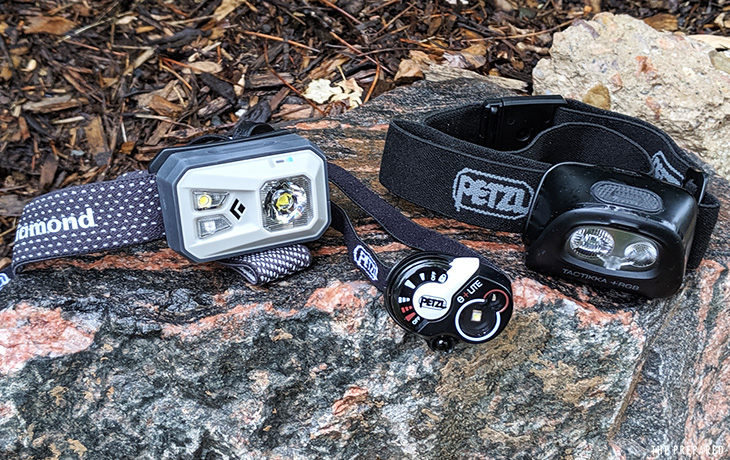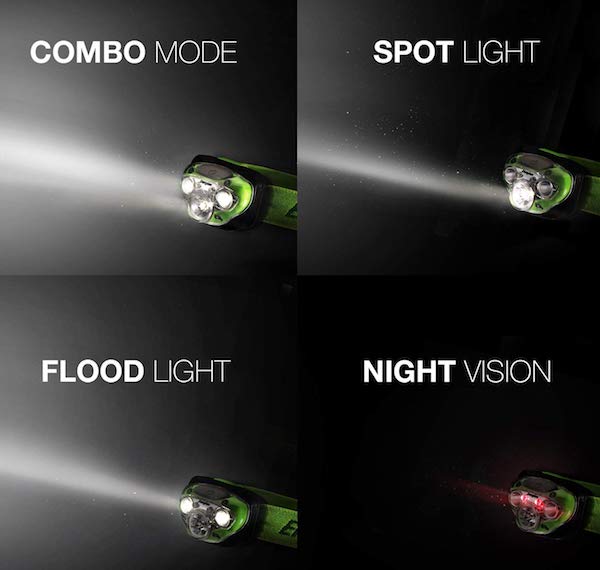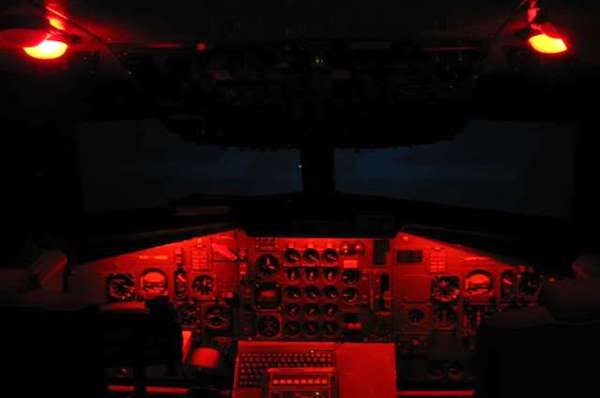Hands-free headlamps are invaluable and endlessly useful in emergencies. Imagine you have to change a tire or help a wounded person in the dark. Are you going to hold a flashlight with one hand and work with the other?
Keeping both hands free while light automatically points where you’re looking — which avoids wasting energy where you’re not looking — is very handy for preppers, hikers, campers, hunters, mechanics, and anyone who works with their hands.
If you only have one powered light source in your emergency supplies, we’d recommend a headlamp. But the best answer is a mix of powered and unpowered lights of different types, including multiple headlamps:
- A primary, high-quality headlamp in your bug out bag and another in your get home bag. Since your bug out bag is always at home, you’ll have that main lamp even when staying in.
- Secondary or backup headlamps for home supplies, everyday carry, or various places like cars/boats and sheds/barns. These can be cheaper than the main lamps.
- Headlamps work in tandem with any handheld flashlights and candles/fire sources you may have.
Industry insiders report that the last few years have seen major improvements in core product tech like brightness, battery life, and power versatility — creating an even better return on investment for every prepper.
We particularly love that affordable headlamps can now run off USB-rechargeable and common AA/AAA disposable batteries — a perfect combination for emergency preparedness that adapts to unpredictable situations without any extra or uncommon gear. At this point there’s no reason to spend over $25 and not get one of these versatile options highlighted below!
Keep in mind that most reviews of headlamps are focused on normal-life activities, such as jogging or auto repair, not on emergency preparedness. Context matters!
Full list of products, reviews, our criteria, and more below the table of contents.
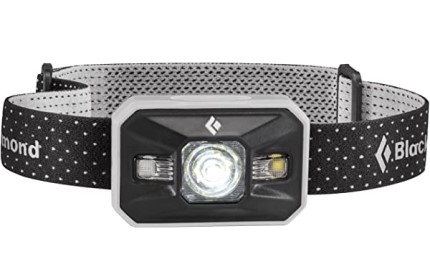
Best for most people:
Black Diamond ReVolt 350
The primary headlamp you should rely on in your bug out and get home bags is the $50 Black Diamond ReVolt 350. Not only does the ReVolt have that oh-so-sweet battery versatility preppers crave, but it crams all of our important criteria into a well-reviewed package from a reputable company at a price point that’s cheaper than the competition. Produces a very respectable 350 lumens up to 80 meters away, with a long 200 hour life in low mode. Includes red light for night vision, spot and flood modes, a lockout mode that prevents an accidental turn on (and battery drain) when rumbling around your emergency kits, and best-in-class IPX4 waterproofing.
Be prepared. Don’t be a victim.
Want more great content and giveaways? Sign up for The Prepared’s free newsletter and get the best prepping content straight to your inbox. 1-2 emails a month, 0% spam.
Great bang for your buck:
Energizer Vision HD+
Tiny but powerful:
Petzl e+Lite
Why you should trust us
We’ve spent 25 hours reviewing over 200 different headlamp models for this article. We’ve used many of these models in the backcountry over the last 10 years, especially those from notable brands, although we have not field tested all of the models in this review. This guide will be updated as we physically test more models.
How we review headlamps for emergencies
We focus on these criteria, roughly in order starting with the most important:
- Power versatility — can it use disposable and rechargeable power, does it use common or weird batteries
- Mix of battery life, brightness, and range
- Durability and weatherproofing
- Light modes — does it offer spot and flood modes, at least one red light mode, dimmable, etc.
- Cost
- Ease of use
- Weight
- Lockout mode that prevents the light from accidentally turning on in your emergency bags.
- Stealthiness — muted colors, non-reflective head straps, etc.
Some basic features are mandatory, such as models that have a hinge/tilt so you can point the light where you need it.
We report distance in terms of max range on highest power setting. Battery life is reported on the lowest setting. If the unit can use both disposable and rechargeable batteries, time is reported for the disposables where possible. Weight includes batteries.
Headlamp features and costs
Most headlamps relevant for personal prepping fall into a few price tiers:
- $10-20: Budget
- $20-35: Decent mix of budget vs. quality
- $35-60: Best sweet spot for most people
- >$60: Upgrades and specialty lamps
Top brands: Black Diamond, Petzl, Coast, Fenix, SureFire, ZebraLight, Armytek, Nitecore, Olight, Acebeam
Mid: Ledlenser, Nite Ize, Princeton Tec, UCO, Nathan, Streamlight
Budget: Energizer, Emergency Essentials, Foxelli, Vitchelo, UltraFire
Headlamps are one of those product classes that have a lot of white label and rebranded listings, especially at the cheapest tiers, so we try to stick to the known and notable brands.
Attachment style
Two basic types: “cap” lights that clip on to the brim of a hat or helmet and “caving” or “miner” lights that have a headband strap.
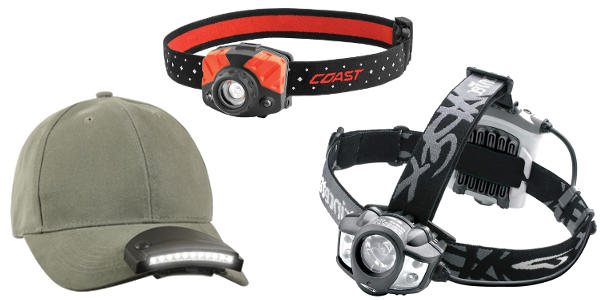
We disqualify the cap-style lamps for prepping. They can be useful as a small backup or something casual. But we don’t like them for your primary choices because they’re unusable if you don’t have a hat — and we don’t want to limit our options in emergencies. Headbands really don’t add much weight or volume, and they can work with hats anyway, so there’s no solid reason to avoid them.
Power and rechargeable vs. disposable batteries
Most consumer headlamps use AAA disposable batteries. Some use AAs. Specialty lamps, particularly those for military or industrial needs, can use less common battery styles like CR123s.
We love headlamps that can use either USB rechargeable or normal AA/AAA batteries.
A hiker might not care that their headlamp uses uncommon batteries because they’ll just go to the store and buy a new one. But you don’t want to be in that situation, so we disqualify anything that doesn’t use AA/AAA.
A growing number use rechargeable lithium-ion batteries, either in individual AAA-style or as a single battery pack (like your phone’s battery). Some models are versatile enough to use both.
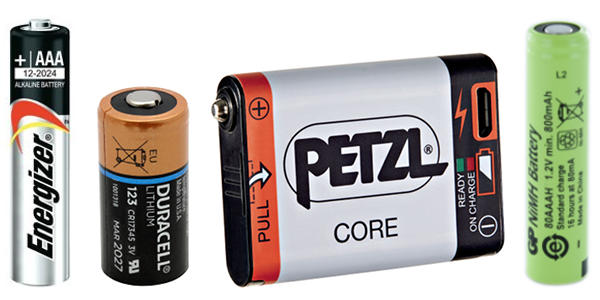
Recharging usually happens through a micro USB port — the same cable/port used on many phones, portable power packs, crank- or solar-powered emergency radios, etc.
If a model can only do one or the other, we tend to prefer normal disposable batteries. Disposable batteries better hold their charge when stored for extended periods of time and produce brighter lamp output for longer.
Battery life
Comparing battery life between products is tricky. Obviously a 500-lumen light will drain a battery faster than 100 lumens. But when manufacturers promote their battery life, they’re typically referring to the life when in the lowest white-light mode. So a light that can reach a maximum of 300 lumens might only get 2 hours at that brightness, yet can run for 200 hours at 10 lumens.
Brightness / lumens
Headlamp brightness is typically measured in lumens. A standard 60-watt light bulb in your home generates 600-800 lumens. Headlamps usually fall in these ranges:
- 25-100 lumens: Good for simple things like going to the bathroom at night.
- 100-200 lumens: Better for simple outside work, like cleaning up a campsite at night.
- 200-300 lumens: Better for finding trails in the dark or moving at faster speeds (like jogging).
- 300-500 lumens: You’ll be able to do any normal outside activity.
- >500 lumens: Typically used for technical skills, like rock climbing at night, or industrial jobs.
Light modes
Not all lights are created equal. For example, some lamps are designed specifically for a narrow beam that shoots far ahead, so that someone running quickly on a dark forest trail can see what’s coming — yet that same light would be unhelpful when working around the house during a power outage.

Modes vary based on:
- how focused/far or wide/near the light beam is (narrow spot vs. wide flood)
- what color the light is (red vs. white, sometimes other colors)
- how intense the light is (dim adjustments)
- if the light is always on or flashing/strobing (sometimes in morse code for S.O.S.)
We prefer models that have a balanced mix of spot vs. flood (ideally with controls to adjust the balance between them) and a red light mode.
Red light is commonly used because it doesn’t screw up your night vision as much as other colors. You’ve probably seen military movies where soldiers are reading a map or flying in a cockpit using a faint red glow:
Red light is helpful for up-close activity, like reading a map or changing a tire. It’s not very useful beyond two meters (six feet). There’s also a tactical advantage to red light: You’re less likely to be spotted by others in situations where you don’t want to be seen, and you’re less likely to blind other people in your party.
Waterproof headlamps
Electricity and water don’t mix, and since the headlamp is sitting on your head, it’s usually exposed to rain, snow, or tripping face first into a puddle.
Products like phones and flashlights have an IPX rating. They are standards based on water testing:
- IPX 1: Can handle dripping water from above for 10 minutes.
- IPX 4: Can handle splashes of water from any direction for five minutes.
- IPX 7: Can handle submerging completely under water for 30 minutes at 1 meter deep.
- IPX 8: The same as 7, but with a little extra, although that’s defined by each company and not really a standard.
Good manufacturers will proactively identify their IPX rating and what it means. Others will say “waterproof” or “water resistant”, which usually means IPX7-8 and IPX4, respectively. Be skeptical if a company only uses vague terms like “weather resistant!”
Ease of use
Ease of use is a tricky criterion. We always like the “10 year old child test” when evaluating emergency products, because you want gear that’s simple and intuitive enough that a 10 year old can use it in a crisis without any help or manual.
But there’s a tradeoff: Controls are simpler when the lamp has fewer important features, such as red night vision modes or a lockout mode that prevents it from accidentally turning on in your bag and wasting battery life.
Some of the most popular headlamps (like the Black Diamond Spot) are less intuitive than the competition. It often comes down to having one button versus two buttons or a spinning dial.
A common annoyance is whether you have to toggle through the white light modes in order to get to the red light mode, or vice versa. Although we prefer models where you can directly turn the red mode on and off without touching the white modes, it’s not a dealbreaker — you’ll learn to cover the light with one hand while toggling the button with the other hand.
Best headlamps for emergency bags and home supplies

Best for most people:
Black Diamond ReVolt 350
Our top choice for the primary headlamp most people should rely on in an emergency (and thus keep in their bug out bag and get home bag) is the $50 Black Diamond ReVolt 350. Black Diamond is one of the most popular headlamp companies, with the ReVolt, Spot, and Storm models often winning in-depth reviews from publications focused on outdoor activities like hiking, camping, climbing, and hunting.
The ReVolt comes with the versatility to use either the included micro-USB rechargeable batteries or common AAA disposables. Even better, the ReVolt is the cheapest option with that versatility, yet has better light output, life, waterproofing, and features than more expensive competitors.
Instead of a singular, proprietary rechargeable battery pack (like the Petzl CORE), the ReVolt comes with three rechargeable AAA-style batteries — which means you can use third-party rechargeable batteries, too. But it does take a little bit of elbow grease to fit third party batteries, because you have to peel/cut the battery wrapper veneer back a little bit so they can make contact with the electrical leads. It’s easy to assume Black Diamond did this to force you to use their branded rechargeables, but it’s actually more of a safety feature, because if you accidentally try to recharge a normal alkaline battery it can cause serious damage. In the end, we didn’t think this was a big deal because it’s easy to overcome if you really needed to:
Here’s our biggest criticism of Black Diamond lights: The user interface can get a little confusing with only one button to control so many features. That means the ReVolt and other BD models don’t pass our “10 year old child without instructions” test. However, this isn’t enough to keep us from choosing the ReVolt, and in a SHTF pinch you’ll be able to press or press and hold the button and figure things out yourself with a little trial and error.
If you like the Petzl family, your choice comes down to whether you buy a model that’s ready for rechargeable + disposable power options right away, versus buying a cheaper base model and adding the $30 Petzl CORE rechargeable battery accessory later on. You’ll pay more if you buy the battery separately, but it can help break up the cost if you’re on a tight budget.
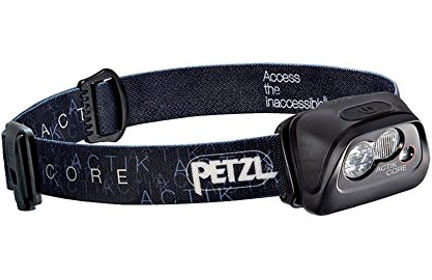
Cheapest Petzl recharge + disposable:
Petzl Actik Core
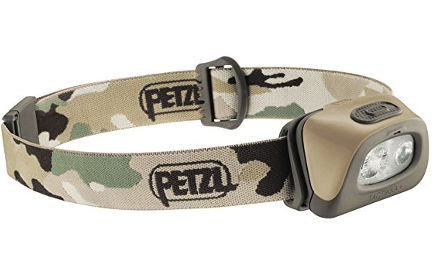
Long life in a light package:
Petzl Tactikka+
The well-reviewed and popular $70 Petzl Actik Core is the one option for rechargeable + disposable out of the box, whereas the $50 Petzl Tactikka+ uses three AAA disposables until you add the $30 aftermarket CORE battery. The Actik Core also has a lock out feature to prevent accidentally turning on inside your pack, has a 100 lumen brighter max setting, and is 10g lighter than the Tactikka+. Although, the Tactikka+ does have a slightly longer battery run time and a non-reflective headband, aiding in stealth. Also great is that all of the Petzl headlamps in this review are compatible with the protective carrying case that doubles as a lantern accessory.
Top contenders
| Model | Price | Lumens | Life (hrs) | Range (m) | Weight (oz) | IPX # | Versatile power? |
|---|---|---|---|---|---|---|---|
| Black Diamond ReVolt 350 | $50 | 350 | 200 | 82 | 3.2 | 4 | Yes |
| Ledlenser MH6 | $40 | 200 | 20 | 120 | 3.3 | 6 | Yes |
| Petzl Actik | $80 (50+30) | 350 | 120 | 80 | 3.0 | 4 | Yes (extra) |
| Petzl Actik Core | $70 | 450 | 130 | 90 | 2.7 | 4 | Yes |
| Petzl Tactikka+ | $50 (50+30) | 350 | 160 | 90 | 3.0 | 4 | Yes (extra) |
| Petzl Tikka | $60 (30+30) | 300 | 120 | 65 | 2.9 | 4 | Yes (extra) |
| Streamlight Double Clutch Rechargeable | $40 | 125 | 18 | 82 | 4.0-4.7 | 4 | Yes |
Competition
Armytek Tiara A1 / Pro. $65. We like that the torch element in Armytek headlamps is removable so you can stand it flat on a surface or use it as a handheld flashlight. While Armytek lamps are well-built and produce quality light, we think they’re overpriced for prepping, especially while lacking basics like red light night modes.
Black Diamond ReVolt 350. $50. Lockout mode. Battery life meter. Red light mode that you can activate without cycling through the white modes.
Black Diamond Spot 300. $35. Lockout mode. Battery life meter. Red light mode that you can activate without cycling through the white modes. One of the best mixes of cost vs. brightness vs. battery life. The Spot is one of the most often-recommended headlamps, but keep in mind those reviews aren’t thinking about emergencies.
Black Diamond Sprinter. $50. This model is intended for night runners, which means the red light only faces backwards as a taillight and the main light doesn’t have a proximity mode for close-up work around camp. Has top strap and rear-facing battery pack for balance. Great for running, but not for prepping.
Black Diamond Storm. $55. Lockout mode. Battery life meter. Red light mode with extra blue and green modes, can activate without cycling through white modes. Strobe mode. There are many reports of a buzzing sound from the headlamp, and we think the price / weight / brightness / battery ratios are worse than the alternatives. But the Storm is well reviewed, with some outdoor-oriented publications making it their top pick, even above its brother the Spot.
Coast FL60. $30. Simple wide-angle flood beam without focus or a red light mode. Headband strap is reflective, which might be bad for prepping. Also comes in the rechargeable FL60R version, which pumps out 450 lumens, but is overly expensive at $105 MSRP. Lifetime warranty. If you want a Coast lamp, get the FL75 (brighter) or HL7 (longer life) instead.
Coast FL75. $45. A decent alternative if you don’t care about rechargeable versatility. One of the best price:lumen ratios with a whopping 435 lumens for only $45, and Coast is known for their high quality visual light output. Intuitive to use with simple twist-to-focus light. Red light mode without toggling through white modes. Headband strap is reflective. Also comes in the 75R rechargeable model, but is overly expensive at $105 MSRP. Lifetime warranty.
Coast HL7. $40. Less bright than the FL75 but with a much better battery life. Hinged light, but many reviewers complain of the hinge breaking. No red light mode. The HL# models below HL7 don’t offer a focusing beam, which is worth it, but the unique dimmer lever that adjusts brightness is a feature we’d rather avoid. Battery pack is on the back strap for weight balance. Also comes in HL7R rechargeable version at $75. Lifetime warranty.
Dewalt DWHT81424. $22. Is designed to be worn over a hard hat, so it gets uncomfortable if worn on your bare head. No red light mode. Basic functionality. Overpriced for what you get.
Fenix HL40R. $60. The HL40R is a decent lamp, but isn’t great for preppers because it doesn’t have rechargeable + disposable combo — which you get for the same $60 in our winning model.
Fenix HL60R. $80. Outputs a high 950 lumens off a micro USB rechargeable battery, but uses 2 CR123A batteries for disposable backups. There’s a lot we like about this model, but we can’t recommend it for prepping because of the less common CR batteries. If you’re going to have a rechargeable headlamp that can also take disposable batteries in an emergency, they need to be the common AA or AAA type.
Ledlenser MH2. $20. No red light. Lockout mode. A basic but decent model from a reputable mid-tier company, but not enough to jump.
Ledlenser MH6. $40. Ledlenser’s website and product info are frustratingly incomplete, but this model uses 3 AAA-style rechargeable batteries, which means you can also use disposable AAA backups. Poor battery life numbers. Lockout mode. The MH6 is comparable to the Black Diamond ReVolt, although the ReVolt has more positive reviews and top choice awards.
Ledlenser MH10. $100. This USB-rechargeable model can’t take AA/AAA batteries as a backup. It’s also very heavy at 9.3 oz.
Ledlenser SEO 3. $35. We dislike this model because it only comes in bright green or orange colors and has a low price:lumens ratio.
Ledlenser SEO 5. $30. Another Ledlenser model that might be fine in a vacuum, but loses to competitors on price/brightness/battery life ratios.
Nathan Halo Fire. $40. Rechargeable, but doesn’t take AA/AAA batteries, and has a low battery life. We think it’s overpriced for what you get in a prepping context.
Nathan Neutron Fire. $30. Too many reports of quality and durability problems with this model. Plus it has relatively low brightness levels with a max of 90 lumens, the same as the Ledlenser NEO at twice the price. The $45 Neutron Fire RX model is rechargeable, but can’t take disposable batteries.
Nite Ize Inova STS. $35. A very decent lamp that could’ve been a contender under $35, although many reviewers prefer the Black Diamond Spot in this price range. High 265 lumen output for 70 meters or a 108 hour life in low mode. STS stands for Swipe-To-Shine, a unique tech that uses a finger swiping motion instead of normal push buttons to control brightness along a spectrum from dim to bright. We don’t have a specific reason to believe so, but something about that tech makes us nervous for prepping gear. We like simple buttons and dials.
Nite Ize Radiant 250. $30. Hinged light that can pivot a full 90 degrees. Red light mode. Battery life is lacking compared to the similar and cheaper BD Spot and Petzl Tikkina.
Nite Ize Radiant 250 Rechargeable. $40. Another oh-so-close model from Nite Ize. 250 lumens, 92 m range (301 ft), 43 hour life, and only 3.2 oz weight. Separate switch for red light mode. Battery life indicator. Rechargeable, but it doesn’t take AA/AAA backups.
Petzl Actik. $50. The base Actik uses 3 AAA batteries or the CORE Hybrid rechargeable battery for an extra $30. Solid range, brightness, life, and weight. Red light and red strobe. The Actik is a close contender and a great overall lamp.
Petzl Actik Core. $70. One of our top contenders, the Actik Core would’ve been closer to #1 if it had a less reflective headband. We love that the CORE rechargeable battery has the USB plug built right in, so you don’t have to carry (or risk losing) a charging cradle.
Petzl Tactikka / Tactikka+. $30 / $50. Another Petzl model that’s very solid and one of our top contenders. The Tactikka line is designed for stealthy activities like hunting (as opposed to the more hiking/climbing-type Petzl models), and one reviewer claimed they used it over five Middle East military deployments. We like this line because it doesn’t have extra bells and whistles you don’t need, but is compatible with Petzl’s Hybrid CORE system, so you can swap between disposable and rechargeable batteries. Non reflective headband. Red light. No lockout mode (why Petzl, why?!) The Tactikka+ is $20 more than the base model for an extra 50 lumens (350 vs. 300).
Petzl Tikka. $30. Tikka and Tactikka are pretty similar, with the Tikka built more for running/hiking needs, so we prefer the Tactikka line. There was a Tikka+ model but it looks like Petzl is no longer offering it. Tikka uses 3 AAA disposables and is compatible with the CORE rechargeable battery (an extra $30). Another neat feature: The light housing glows green in the dark, making it easy to find in your bag. Red light and red strobe modes. It’s cheaper little brother is the $20 Petzl Tikkina at 150 lumens, which is also compatible with the CORE hybrid battery but doesn’t have red lights or the glow.
Princeton Tec Byte Tactical. $28. For $10 more than the base Byte, the Tactical version offers a more neutral-colored headband (worth it), extra battery life (worth it), and an extra mode for low red light (not worth it) — but at $30 we think there are better options.
Princeton Tec Apex Rechargeable. $170. No red light. No lockout mode. Too expensive and too heavy, plus it can’t take disposable backups.
Princeton Tec EOS. $45. The EOS was frequently mentioned in older prepper forums because it’s very rugged and simple, but we think there are better options above $30. The Tactical model only throws 60 lumens but has a higher life at 108 hours and adds a red filter that you physically slide up in front of the bulb, which we really dislike.
Princeton Tec Remix / Plus / Rechargeable. $40-50: Princeton Tec really needs to make their SKUs less complex and confusing. The Remix series gets into multiple versions based on combos of white, red, green, and blue LEDs. The right mix could be a fine lamp in the field, with decent range, life, weight, etc. The Pro is disqualified for using CR123 batteries. The Rechargeable is too heavy at 5.5 oz and doesn’t have night vision, although it can take 3 AAA backups. The Remix Plus uses 4 AAA batteries held on the rear of the headband.
Princeton Tec Quad / Tactical. $30. The base Quad has some nice features, like a battery life indicator, but it lacks a red light and the 78 lumen output is just too low to compete above $30. The Tactical adds colored lens filters in red, blue, and green, but we dislike that method of coloring.
Princeton Tec Vizz / Tactical. $42 / $65. A worthy lamp among the disposable-batteries-only competition. 420 lumens, 78 m range (255 ft), and 110 hour life on 3 AAA batteries. 3.2 oz weight. IPX7 waterproof. Red light mode activated without toggling through white modes. Lockout mode. Battery life indicator. High reports of quality and battery life issues — but PTEC claims they were fixed in 2018, in addition to an upgrade from 205 to 420 lumens. The Vizz Tactical adds blue, green, and infrared options, which aren’t worth the upgrade. As of publishing, many stores are still carrying the older 205-lumen version at $20, which isn’t worth it due to the quality issues.
Streamlight Argo. $30. Well reviewed, but designed for throwing light a very long distance — up to 190 meters (623 ft) — at the sacrifice of battery life and flood lights for comfortable up-close work.
Streamlight Double Clutch Rechargeable. $47. One of our top contenders due to the mix of rechargeable and disposable battery options, but the lack of a red light keeps the Double Clutch from winning, and brightness and battery life are low at 125 lumens and 18 hours. Works great with gloves on because you twist the large face cap instead of pushing buttons. Well reviewed as a work-oriented headlamp, rather than the more hiking-oriented ones from brands like Petzl.
Streamlight Enduro Pro. $25. The Pro upgrade over the $15 Enduro adds red or green night light modes and better battery life — although the numbers are still weaker than the competition.
Streamlight Septor. $28. Very similar to the Streamlight Trident, but with a different mix of LEDs arranged for a flood light. Higher lumens than the Trident at 120 to 80, but only reaches half as far. Similar weight to the 5.5 oz Trident, which is ~40% heavier than competitors.
Streamlight Twin-Task Rechargeable. $58. A decent headlamp that throws 375 lumens up to 121 meters (397 ft). But at $58, there are better alternatives that include features like AAA battery backup, lockout mode, and red light that the Twin-Task is lacking.
ZebraLight H53Fw. $59. ZebraLight is a favorite among flashlight nerds because they make quality products with great light output and life. But we find their product lines to be unnecessarily complicated and many of their affordable models are lacking features like red light modes and adjustable spot vs. flood white modes. The H53w is one of the only applicable models, using a single AA battery with a mix of flood and spot modes, but no red light.
Best spare or budget headlamp under $25
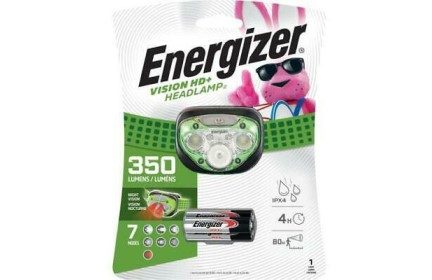
Great bang for your buck:
Energizer Vision HD+
The under-$25 tier is riddled with knockoffs, white-labels, and cheap products that aren’t worth buying. But there are a few good options worth considering, and we like the $15 Energizer Vision HD+ because it’s from a reputable company with enough of the right features. The $20 Energizer Vision HD+ Focus upgrades to dual control buttons, so you can turn the red light on and off without toggling through blinding white lights. It also adds a “focus” feature so you can control the beam’s distance/width.
The $20 Petzl Tikkina is a great choice, especially if you’re going to use Petzl headlamps for your main gear, because it’s compatible with Petzl’s $30 Hybrid CORE battery system — you can share the same USB-rechargeable battery pack across models. The biggest issue with the Tikkina is a lack of red night vision lights, something the Energizers and cheaper alternatives offer. But you gain a large amount of battery life compared to the Vision HD+ models (220 hours vs. 50) at the expense of lower brightness (150 lumens vs. 250), a tradeoff we’re happy to make in the spare / budget class.
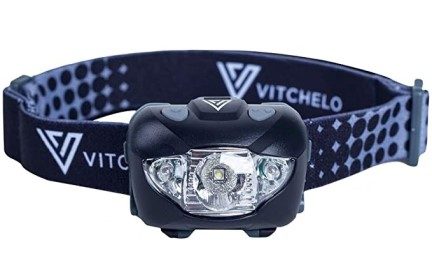
Cheapest acceptable choice:
Vitchelo V800
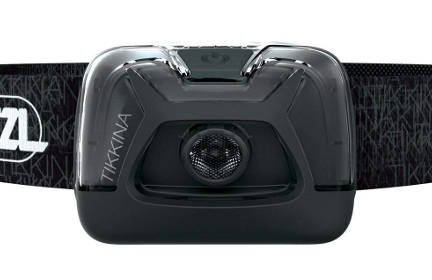
Compatible with CORE:
Petzl Tikkina
Top contenders
| Model | Price | Lumens | Life (hrs) | Range (m) | Weight (oz) | Power | IPX # | Red light? |
|---|---|---|---|---|---|---|---|---|
| Black Diamond Spot | $22 | 200 | 60 | 64 | 2.8 | 2x AAA | 8 | Yes |
| Energizer Vision HD+ | $15 | 350 | 50 | 70 | 3.1 | 3x AAA | 4 | Yes |
| Energizer Vision HD+ Focus | $20 | 315 | 40 | 85 | 3.2 | 3x AAA | 4 | Yes |
| Petzl Takkina | $20 | 150 | 220 | 55 | 3.0 | 3x AAA or Petzl CORE rechargeable | 4 | No |
| Streamlight Trident | $25 | 80 | 53 | 126 | 5.5 | 3x AAA | 4 | No |
| Vitchelo V800 | $15 | 168 | 120 | 110 | 3.2 | 3x AAA | 6 | Yes |
Competition
Black Diamond Astro. $30. No red light. Black Diamond is one of the more popular brands, but their sweet spot is in the $30-60 tier. The Astro’s brother, the Spotf, is the better Black Diamond choice in the budget tier.
Black Diamond Spot. $22. A great 200 lumen headlamp by Black Diamond that runs on two AAAs. Includes a lockout mode, IPX8 waterproof rating, and red night vision light, features lacking in the similarly-priced Astro. But the Petzl Tikkina is a better choice at this price.
Energizer Vision HD+. $15. Energizer Vision models range from the $9 base Vision to the $30-40 Vision Ultra. The HD+, HD+ Focus, and Ultra are the models worth considering because they add IPX4 weather resistance and red, spot, and flood light modes.
Energizer Vision HD+ Focus. $20. The HD+ Focus adds a focusing feature (surprise!) with more light modes, although we dislike the cheap plastic focus buttons. Energizer’s top model, the Ultra, bumps the output up to 400 lumens with an extra green light night vision mode — but at that price and output level, we’d rather go with the more-notable outdoor brands like Black Diamond or Petzl.
Foxelli MX20. $11. While it seems like a decent budget lamp, there are reports of leaky electricity that drains your batteries when stored — a no-go for prepping needs.
Ledlenser NEO. $20. Because this small and basic light is built for casual activities, like jogging before sunrise, it only comes in loud colors and has a unique blinking red light on the rear headband.
Petzl Tikkina. $20. The well-reviewed Tikkina would’ve won this category if it had a red light mode and two controls buttons (so you can get to night vision without toggling through white modes). It’s the only cheap headlamp compatible with rechargeable batteries, in this case Petzl’s $30 CORE Hybrid — worth considering if you’re using CORE Petzls anyway.
Princeton Tec Byte. $20. Red light is accessible without toggling through white light. Tilts. Lockout mode. Seems like a decent light with just the right mix of basic features in a super-lightweight package, but the overall output and battery life struggles at $20 when compared to the other models, and there are higher than normal reports of quality troubles for this otherwise-reputable brand.
Streamlight Enduro. $21. One of the cheapest Streamlight options, but there are too many reports of quality and durability problems, particularly around the battery compartment.
Streamlight Bandit. $23. Rechargeable, but through an integrated battery you can’t replace or swap out with disposable backups. Nice, wide flood beam.
Streamlight Trident. $28. No red light. Low battery indicator. Top strap. The Green Trident model comes with a green LED for night vision, but the product is still weak compared to competitors.
UCO Beta. $22. UCO seemed to care about form over function with the Beta. The unnecessary wood inlay adds weight while sacrificing important features like a red light mode. Brightness and beam distance are weak for a >$25 3xAAA battery lamp.
Vitchelo V800. $15. Red light mode activated separately from white modes. 45-degree hinge. A decent light under $15 — some reviewers claim it’s great for the price, other reviewers disagree. The V800 sacrifices light quality in order to reach further distances for longer, and it doesn’t work well for up-close applications.
Best ultralight or compact headlamps for EDC
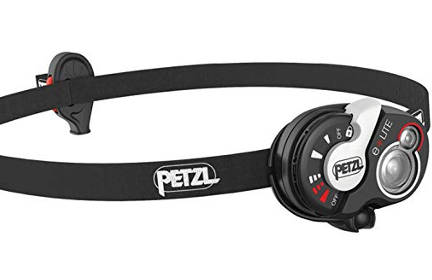
Tiny but powerful:
Petzl e+Lite
Competition
| Model | Price | Lumens | Life (hrs) | Range (m) | Weight (oz) |
|---|---|---|---|---|---|
| Petzl Bindi | $45 | 200 | 50 | 36 | 1.23 |
| Petzl e+Lite | $30 | 50 | 12 | 6 | 0.92 |
| Petzl Zipka | $30 | 200 | 240 | 60 | 2.3 |
Petzl e+Lite. $30. Runs on a CR 2032 battery. Red light. Lockout mode. Ridiculously small headlamp that weighs the same as a normal BIC lighter. We would normally disqualify this model for using an uncommon battery, but we like the rest of the features, it’s not your primary lamp, and Petzl claims it can be stored for up to 10 years before replacing the battery. Has an emergency whistle built into the strap.
Petzl Zipka. $30. A unique design with retractable cables instead of the standard fabric/elastic headband — but we wonder if it’s worth it, given the lamp portion is the same size/weight and normal headbands aren’t that bulky to pack. The cables make it easier to use this lamp in non-standard ways, such as attaching it to an animal, pack, or tree. Runs on 3 AAA batteries, but you can also add Petzl’s Hybrid CORE rechargeable battery system. One of the few models on our list that isn’t hinged or tiltable.
Upgrade and specialty options
Hardcore flashlight enthusiasts typically won’t buy the more mainstream models identified above. That’s fine, but we find that most preppers just want something reasonably affordable, easy to buy, and easy to use — qualities the enthusiast-level products are lacking.
Rather than identify top choices for upgrade picks, until we can do more hands-on testing with “torch nerds”, below are some of the options you might consider if you really want an uber-bright light or some other specific feature — such as a removable battery pack to prolong life in extremely cold climates.
A recent trend is “auto dynamic lighting”, where sensors on the headlamp try to judge what’s happening around you, automatically adjusting the light to the “right” brightness level. It comes in different Capital Letter Marketing Names like “OptiSense Technology”. We don’t think this tech is worth paying for at all, and there are many reports the tech is immature and fails in the snow, rain, etc.
Black Diamond Icon. $100. 700 lumens. 4 AA batteries. 175 hour life. 10.6 oz weight. 100 m range. IPX67 waterproof, particularly good for saltwater and dusty environments. Battery life meter. Top strap. Black Diamond’s most powerful option. Battery pack is removable so you run it in severe cold without battery drain. All standard output modes plus green and blue light and a proximity beam. There are reports of durability issues with this model (although it does have a 3 year warranty), plus some ambient noise from the light source.
Coast FL85. $45. Pumps out a high quality and huge 615 lumens on 3 AAA batteries, so the max life is only 13 hours. 4.5 oz weight. 183 m range (600 ft). IPX4 water resistant. Twist to focus spot vs. flood. Red light mode with separate button so you don’t toggle through white modes. Also comes in the 85R rechargeable model, but is overly expensive at $125 MSRP.
Ledlenser SEO 7R. $80. The SEO 7R is one of the models pitching the trendy “automatically detects your ambient light and adjusts the brightness accordingly” features we dislike.
Petzl Reactik / Reactik+. $85 . Another “reactive lighting technology” series. The Plus model adds bluetooth and phone app support — the last things we’d want in a prepping headlamp.
Princeton Tec Apex / Extreme / Pro. $80/$110/$105. High 500-lumen output lamps with extremely long battery life (>200 hours). Skip the Pro, it uses non-standard CR batteries and is made for hard hats. The Apex takes 4 AA batteries and the Apex Extreme uses a whopping 8 AAs. The advantage to these models is the detachable battery pack — great for extremely cold environments where you keep the pack inside a jacket pocket for warmth (severe cold crushes battery life). But it lacks lockout and red light modes.
Streamlight ProTac HL Rechargeable. $102. Very bright at 1,000 lumens (with the poor battery life to match), but it can’t take disposable battery backups and there are reports of quality troubles with charging. Limited light modes with physical red and flood lenses you insert over the light, which we strongly dislike.
SureFire Minimus. $180 SureFire makes great products (we use and love their weapon lights). But at >$180 for the base Minimus and $250 for the rechargeable version, they’re just too expensive and overkill for the vast majority of preppers. The base model uses CR123 batteries, the same batteries used in SureFire’s infamous Scout weapon lights. We like the rugged construction and easy to use yet granular brightness control, but dislike the detachable red filter that’s just begging to be lost.
ZebraLight H600w Mk IV. $90. OutdoorGearLab’s highest-scoring headlamp in 2018. Same story as the Zebralight H53: Zebralight makes great lights that are popular among flashlight enthusiasts but often overkill for the vast majority of preppers. We also find their product mixes to be overly-confusing for normal consumers. The 875-lumen H600w Mk IV is expensive, requiring an extra rechargeable battery that adds even more cost, but without the benefit of disposable battery backups. No red light mode.
